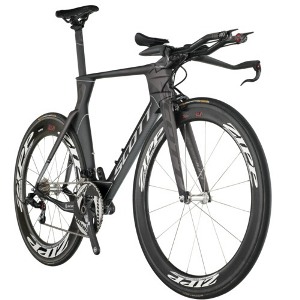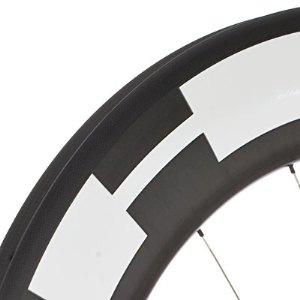Bearing Breakdown
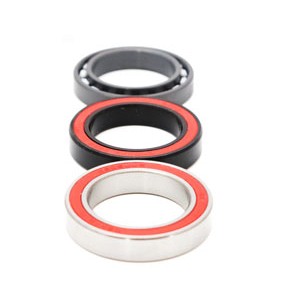
What kind of bearings should you use on your bike? Common question… I get it all the time. Ceramic is better, right? Just like carbon is better for anything on a bike. Should I use a hybrid ceramic… a full ceramic? You may simply just be asking yourself what the heck that means, or if I’m just crazy. While I hope to convince you that the latter is not true, what I’d like to do my best to explain the former. There is quite a lot of confusion and misunderstanding out there when it comes to bearings as-used in modern bicycles. Let us clear the air…
To begin, we must have the basic understanding that your bike needs bearings in order to roll. Specifically, there are bearings in your wheels’ hubs. The great feature here is that you can stop pedaling and – lord, have mercy – the bike keeps moving. You also have bearings in your bottom bracket (which allow the cranks to spin), rear derailleur pulleys (which allow the drivetrain to spin, and guide the chain to your cassette), and finally headset (which allow your handlebars to turn). A key thing to understand with all of these bearings is that they take some measure of effort to spin. If you can somehow make a bearing that takes less effort to rotate, then you and your bike go faster. Less of your pedaling effort gets lost in the bearing. Keep in mind headset bearings largely get ignored, as there is no real benefit to having a handlebar that turns with slightly less effort. The thing that many people miss, however, is that (as with most things) there is much more than meets the eye…
Bearing History
Now that we understand the basics, let me tell you a story. Once upon a time, bikes had adjustable, loose-ball bearings. They could be completely disassembled and reassembled. They feature two races, one called a cup, and the other a cone. These races house loose ball bearings and act as a guide. Think of it exactly as the words would suggest. A “cup” holds the bearings, and the “cone” goes on top. Picture a small cone pointing down inside a coffee cup. The cone takes up space inside the cup – effectively trapping the ball bearings in to place between the two surfaces. This is where the adjustment feature comes in to play – by manipulating how much space is between the cup and the cone, you determine how much space the ball bearings have to spin around. Too much space results in a condition known as “play”… the bearing will feel loose. Too little space results in binding… it just won’t spin freely like you want it to. There is a middle ground in which you want your bearing to live – a buttery-smooth, perfect middle. The bologna to your white bread, so to speak.
The diagram below details a Campagnolo Record hub, which features a cup-and-cone system. "F" is the cone, "H" is the cup, and "G" are the ball bearings.

With these cup-and-cone bearing systems, the whole thing gets stuffed with grease. Any space between the cup and cone that is not taken up by the ball bearings should ideally be taken up by grease. This slurry keeps the whole system running smoothly and protects the parts from corrosion. As well, the design of the cone usually includes some sort of labyrinth seal on the outside, which attempts to keep water and dirt out.
This traditional type of bearing can also be called “angular contact” due to the way in which the ball bearings are held. The surfaces of the two races – the cup and the cone – are crescent-moon shaped. As they trap the ball bearing, it gets nicely cradled and supported around much of its circumference. Angular contact bearings are designed to take loads in more than one direction; both radial and lateral. On a bike, think of this as pedaling in one of two positions: seated or standing. While seated, the bike is upright; your wheel and bottom bracket bearings only experience radial loading (for the most part). However, if you stand up and climb, the rocking motion of the bike brings lateral, or side-to-side, loading to the equation. When smartly designed, angular contact bearings take in to account the relative loading that will be seen in each direction, and have the races angled accordingly.
Cartridges hit the scene
In more recent history, we’ve seen a large shift away from the use of cup-and-cone bearings on bicycles. What is the replacement? The venerable bearing cartridge. In a cartridge design, the bearing races and ball bearings are one complete unit. This donut-shaped assembly has similar basic features to the cup-and-cone: two races which house ball bearings and grease. The whole thing gets installed in to a hub, bearing cup, or pulley. The races have grooves in them which trap the ball bearings, somewhat similar to the cup-and-cone. The main difference, however, is that most cartridge bearings used on bicycles are a radial design (the grooved races are symmetrical, and only deal with straight “up-and-down” loading). There typically is no adjustment to be had; the bearing unit ideally gets designed with a perfect amount of space between the races and bearings. Note that there are some angular-contact design cartridges out there; most often used in headsets, and some bottom brackets, wheels, and mountain bike rear suspension.
Below is an image of basic cartridge bearing anatomy.

You’ll find that cartridges are often referred to as “sealed” cartridge bearings. They are filled with grease (similar to their cup-and-cone counterparts), and do feature a seal on either side. However, one should not assume this system is actually more sealed than a cup-and-cone. It just doesn’t work that way. In fact, the typical seal on a cartridge bearing isn’t so much a seal, as a deflecting shield against air, dust, and ambient moisture. In order to truly seal a cartridge system, they must have some sort of labyrinth seal on top of the cartridge’s own seal – similar to the old cup-and-cone. But – not all cartridge-using products have this.
“All this information is great. Actually, kind of boring. So why should I care?” I hear you. Boring is my middle name. So what’s the deal – really? Here it is. Some manufacturers tend to tout cartridge bearings as being better than cup-and-cone. They’re sealed, dude. And they’re newer, so that means better. Well, yes and no. They do tend to offer the ability to manufacture parts more cheaply. Take a hub for example. Cup-and-cone designs have precision machined races that the hub manufacturers make themselves. As well, the assembly process requires the additional step of setting the (subjective) adjustment. A cartridge hub simple needs a hole bored in to it, in which a cartridge will be pressed. Now, understand that there are some not-insignificant tolerances that must be achieved for a proper bearing bore, but you can outsource the entire bearing assembly to someone else. Cartridge bearing manufacturing can be done on a huge scale by specialized factories, which brings the cost-per-unit to prices that are quite attractive in comparison to making your own cup-and-cone assembly.
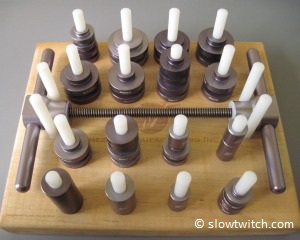
There are a few potential functional problems with cartridges, too. First and foremost, you can't really service them. You replace them. Once they’re contaminated, they’re done. Yes, you can sometimes peel off the outer seal, flush them with solvent, repack with new grease, yadda yadda – but it is never the same as a fresh bearing. Once the system is contaminated and the races are pitted, you’re done. That’s all fine, though – right? ‘Cause the cartridges are so cheap? Well, the cartridges are cheap, but there is another issue that even some highly qualified mechanics do not have the tools to properly replace cartridge bearings. For most wheels and bottom brackets, you need a tool such as the Wheels Manufacturing Wizard (pictured here), or the Enduro press kit. These high quality kits include machined adapters for nearly every common bearing size used on bicycles. I have one of these tools, and it’s great. I use it all the time. But I cannot tell you how many times I have literally blown the minds of other mechanics with it. They have no idea what it is. “WOW – dude! What is that? It looks awesome!” What I wonder in my mind is – how do you not have one? Cartridge bearings have been common on bicycles for well over a decade, and this is the type of tool that you need to replace them. Bearing press kits do not come cheap, but are certainly not out-of-this-world expensive. Many shops spend much more on thread repair tools or frame alignment tools.
So how does one go about replacing cartridges without the proper tool? The old trick is to use a socket and hammer. Go to your trusty socket set, and find one with an outside diameter that is the same as the bearing you want to install. Place bearing on hub… place socket on bearing. Commence hammering (and throw a prayer in there while you’re at it). While this can work, you are at a much greater risk for damaging the bearing – or hub – or installing the bearing crooked – or installing it too hard. Even with something as seemingly perfect as a modern cartridge bearing hub, there is still an art to making it work perfectly. Bearings must be pressed in just so. They must be perfectly straight, and not jammed in to place – either condition can cause binding, as things are not aligned properly. Good mechanics develop a feel for it.
Implications
What the problem mentioned above has strangely manifested itself into is a furthering of what I call “Disposable Bike Syndrome” (send all royalty payments to my personal address). Rather than rebuild that bottom bracket, throw it away, and put a new one in. While I’ll be the first to admit that I really don’t miss those adjustable BBs (and the modern replacements are generally cheap) – it gets more serious when you look at hubs and wheels. With the fast pace of product obsolescence, you may not be able to get a replacement bearing from the manufacturer five or ten years down the road.
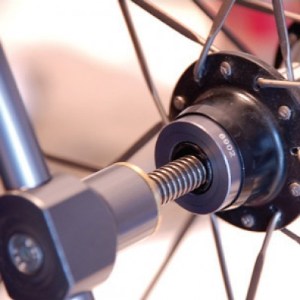
To make matters worse, some products use bearings that simply are not designed for the application. Remember that part about radial vs angular contact bearings? Well, some hubs and bottom brackets use radial bearings – which are only designed to take forces in the vertical plane. If you only ride your bike while seated, and never turn a corner, you’re fine. I don’t know about you, but sometimes I stand up, or sprint, or ride in such a way that is otherwise not a perfectly controlled laboratory condition. In effect, using a radial bearing in an application that will see substantial lateral loads assumes eventual failure. It is possible to help alleviate this issue by using a larger ball bearing size – this “gifts” the design extra load capacity, so it will last somewhat longer. But unfortunately, bearings are the heaviest part of the hub – so more bearing means more weight (which doesn’t help sell product).
So you can’t get a replacement bearing for a wheel which your shop might not have the tools to install, and the type of bearing used in it is guaranteed to fail eventually. Armageddon! Run for the hills! While I am admittedly painting a worst-case-scenario type of picture (c’mon, it’s my job), it is unfortunately not all that far from reality in some cases. What I’ve found is that more and more, one of the most common failures on people’s bikes are rear hub bearings or cartridge bottom brackets. You’re riding along, and hear some sort of click, tick, or creak. In the past, I used to go for things like chainring bolts, cassette lockrings, and quick release skewer tightness. But in the past few years, I’ve been conditioned to take the rear wheel out of the bike, take the cassette off, and dive in to the guts of the rear hub. More often than not, I have a bearing replacement on my hands.
There is one final caveat that must be mentioned – purely in defense of the manufacturers who sell us products using these cartridge bearings. Racing products are just that – meant for racing. When you look at auto racing, for example, it is understood that the equipment’s sole purpose is to forgo longevity for short-term performance. Believe it or not, Ripley, but this applies to bicycles too. How do we make something faster? For one, you make it lighter. How do we make it light? Take away everything that is unnecessary for speed. In something like a hub, this means taking away extra seals, extra grease, and larger bearings with extra load capacity.
You can also make it faster by taking away rolling resistance – with non-contact seals and thin grease. So now you’re got a racing hub (or bottom bracket, or pulley). That’s great. They’re doing their job perfectly; just know what that job is. These types of products require maintenance. You wouldn’t drive a Ferarri without changing the oil, would you? In the case of bearings, this means you’ll be replacing them more often than a training-intended product. Weight is a great guide for what you’re buying. If it’s super light, there is simply less stuff there. Think of it like buying a piece of furniture. When you’re shopping for a desk or kitchen table, what to you go for? Generally speaking, more weight is a sign of the products’ longevity. Buy something heavy and you can pass it on to your grandkids. Buy something light from Ikea, and you’ll be throwing it out after the first time you move.
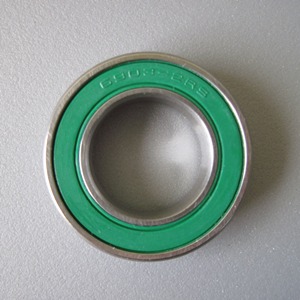
Speedy ceramics
Now that we’re all up to speed and the yawn-worthy education part is over, let’s move on to the good stuff. We all want to go fast, right? And I hear there’s this new-fangled bearing technology called ceramic. They’re the lightning-fast, hot-rodded, Schwartz of bearings. Spaceballs references aside, this is somewhat true. To really understand ceramics, we have to ask ourselves why ANY material is used for bearings.
Most bearings used in cycling applications are good ol’ steel. You’ll find some stainless steel here in there, but usually in headset bearings where the loads are lower (stainless steel bearings tend to have lower load capacities). Around the turn of the millennium, we started to see ceramic bearings show up. But why use it? I thought ceramic was just for Pottery Barn. Well, with steel bearings, there is a functional limit to how round we can make them. At some point, we are limited by the material. With ceramic, the properties of the material say that it can be made in to a bearing that is more perfectly round. Common sense tells us that such a bearing rolls with greater ease – and more speed. This is true indeed. But before you all go clamoring to buy ceramic everything, there are several qualifiers to understand first. Although ceramic has the potential to make a rounder bearing, that in no way assumes that all ceramic bearings are round. I have an analogy for it. Saying a bearing is good because it is ceramic is like saying, “Because this house is made of brick, it is a good house.” But… what about the plumbing, electrical, and so on? It doesn’t tell the whole story. You can have a steel bearing that is rounder than a ceramic bearing, and vice versa. The same holds true for the bearing races; we want them to be as round as possible regardless of material.
There is another misnomer out there that ceramic bearings are unilaterally more durable than steel. The ceramic material itself is harder than steel – yes. So the ball bearings could be called more durable. However, there’s a catch. Most ceramic cartridge bearings on the market are actually hybrid ceramics – meaning that the balls are ceramic, but the surrounding races are steel. So these tough, durable ball bearings are housed in comparatively soft steel. If you use anything but a perfectly round ball bearing in this system, it is actually less durable than a full-steel cartridge. A very hard but non-round ceramic bearing will literally chew up a steel race in a very short order of time (think of it like little rocks or pebbles rolling around in there).
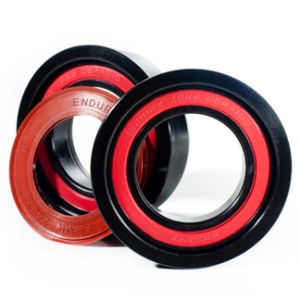
For this reason, I suggest that people either pony up for the highest-grade, most expensive ceramic bearings out there (regardless of manufacturer), or don’t waste your time. I can’t tell you how many times I’ve replaced the cheap ceramic “upgrades”. They tell me, “I just upgraded these wheels to ceramic two months ago… shouldn’t they be faster?” Well, they’re not faster now because it feels like your bearings are full of sand. There are a few full ceramic cartridges out there, which feature both ceramic races and ball bearings. Theoretically, these can be more durable than the hybrids, but the jury is still out in my mind. With each part of the system having such high surface hardness, I’d think that there is zero room for tolerance error. As well, we just don’t see many professional road teams using them yet – and these guys tend to be the most demanding when it comes to equipment performance. Who knows, though – perhaps the test data will prove their superiority and we’ll all be riding full ceramics in ten years.
The other big hidden caveat in ceramic bearings is the fact that nearly every single one on the market uses lighter seals and grease than their steel counterparts. Why is that? Because the customer now has an expectation. An expectation that – ceramics are better and faster, and they should feel that way out of the box. When you plunk down a few hundred bucks for these things, our purchasing minds expect that we got our money’s worth. Nobody wants to feel like they’ve been “had”. This being the case, that bearing needs to feel absolutely-positively like greased lightning when you spin it with your fingers. With what we’ve learned, you now understand that very little of this perception actually has anything to do with the ball bearings inside that cartridge. At best, you got new bearings that were slightly rounder than your old ones. At worst, you got about the same as your old bearings. The reality is that any new bearing just doesn’t have that much drag. We can all thank the cavemen for inventing the wheel, ‘cause round things still work great today! The biggest part of your wattage/speed gain from the special bearings is simply because the outer seals are usually a light-contact or non-contact design, and the grease is less viscous. Non-contact seals have a “zero clearance” fit between the races. A full contact-seal has an interference fit, where it actually presses in to place and causes some drag (and seals the bearing better).
The issue of seals and grease really gets back to the question of ceramics being more “durable” than steel. Are the individual ball bearings more durable? Technically, yes. But the total system can be less durable. The bearings are harder than the races, and the light seals mean that dirt will find its way inside sooner. But again, this product is doing exactly what it should. Race product, remember? It foregoes longevity for short-term performance. Just know that, because cartridges are not really serviceable, you’ll likely be buying a whole new bearing kit every year or two (or possibly sooner if you ride in the rain). If you’ve got the dough – go to town. If not, I suggest sticking with steel bearings. Speaking of performance, exactly how much “free speed” do ceramic bearings gain for you? Test data varies, but you can generally expect a gain of zero to three watts for a fully-upgraded bike, depending on what you buy, and the quality of your stock bearings. Again, this is really one area where you get what you pay for, so if you’re going to do it, buy the best.
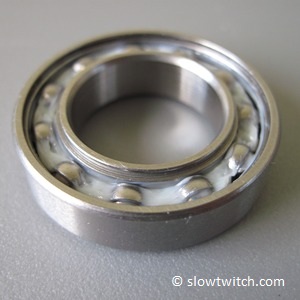
Final Exam
After all the lecturing and data, I hope to offer some sort of take-home advice. In a few sentences: Take care of your bearings. Check them from time to time. Whether you’ve got cartridges, cup-and-cone, ceramic, steel, or kryptonite, the fact of the matter is that they should roll smoothly. Before you worry about upgrading, be sure your standard el-cheapo bearings are in good shape – if they’re making noise or feel rough, it’s costing you watts.
The curious, theoretical nerd in me wants to see someone do a test to determine exactly how much wattage a bad bearing costs you. I’ll throw out a guess and say it’s five watts total for a bottom bracket and set of hubs with toasted bearings. If you’ve ever spun a truly bad bearing with your fingers, you understand how much more effort it require compared to a fresh, smooth bearing (it’s a lot). To make an interesting example, let’s say we have two identical twins racing an Ironman. They did the exact same training, and have the exact same equipment, save one detail. Twin #1 upgraded his wheels and bottom bracket with some hot-rod bearings. Unfortunately, however, he only had enough dough to buy one set, and never replace them. His long training hours included rides in the rain with his dear brother. By the time race day rolls around, his race-day bearings are shot. But he doesn’t know it, because he never bothered to diagnose that creaking noise emanating from his bike. Twin #2, however, stuck with his stock standard bearings. He did the same training rides, and fortunately, his better-sealed bearings survived. On paper, Twin #1’s upgraded bike should be, say, two watts faster. But since his bearings are all crunchy and corroded, he’s actually three watts behind. While it isn’t guaranteed that a steel bearing will last forever, the nice thing is that they are always less costly to replace. I don’t know about you, but I’d rather be Twin #2. Even if his bearings do fail after a year of hard training, hopefully he has the common sense to check them – and replace them – a few weeks before the big race. This example in mind, it should be clear that I don’t care what you choose to ride, as long as you make sure it works. And – no whining and complaining when you buy a racing product and it requires a little extra work.
If you do want to use a more robust design, you may wonder who makes the stuff. Both Campagnolo and Shimano still stand by the old cup-and-cone hub design. Looking at the spec sheet, you cannot deny that these hubs are not the lightest out there (but they’re not the heaviest, either). Whether you care depends on your priorities. Their hubs are known for lasting a long time. If you do want to service them and re-pack the bearings with fresh grease, you can do so with simple hand tools and a bit of your time. The old standby training wheel of Ultegra or Chorus hubs with Mavic Open Pro rims still works astoundingly well.
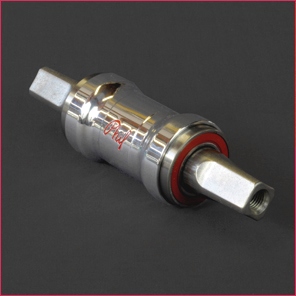
Phil Wood & Co. is known for being one of the first manufacturers to really push the newer cartridge designs, but they do so with a mission statement of “Build it strong, keep it simple, make it work.” Specifically, they tend to use HUGE size bearings in their hubs, along with robust seals and thick grease. I have personally used their cartridge bearings to “upgrade” otherwise race-intended products to be used for training. Even with small radial cartridges, they seem to outlast the racier-counterparts by at least double. You still can’t avoid the bearing’s low load capacity (due to size) and lack of ability to handle lateral loads – but their bearings do remarkably well, all things considered.
When buying anything cartridge-based, look for big bearings, and angular contact whenever possible. If they don’t specify, it usually means the bearings are radial. Enduro has a new bottom bracket called XD-15 that looks very promising. It is available in all modern bottom bracket styles, and features angular contact bearings. As far as I’m personally aware, they offer the only angular contact bearing for BB30 applications. I’ve yet to try them out, but they certainly look like a great solution.
What I’m really encouraging you to do is: Not be that guy (or girl). That triathlete. The one person on the group ride who always has the noisy bike. The new racy products are fantastic, and in most cases offer at least a small measurable wattage benefit. Just understand what you’re buying and be willing to put the work in to it – or bring it to your local mechanic more than once every total lunar eclipse. We all vote with our purchasing power, so buy appropriately and realistically. The most hassle-free bike is never the “fastest” bike on paper. Those without an excess of spare time may be faster in-the-end with a “slower” product that gives them more time to train (or sleep, or whatever). And let’s be honest – they’re just giving us what we asked for. We’re all a bunch of weenies, whether it be weight, aero, or rolling resistance. I’m starting a new category – reliability weenie. Join me?



